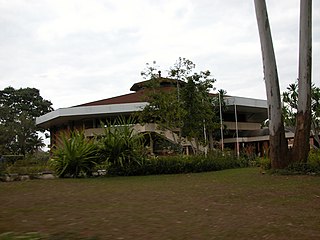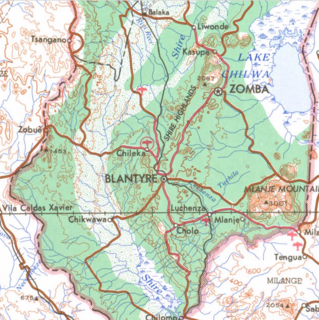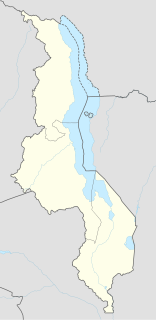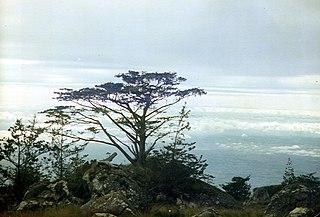
Malawi is a landlocked country in southeast Africa. It is wholly within the tropics; from about 9°30S at its northernmost point to about 17°S at the southernmost tip. The country occupies a thin strip of land between Zambia and Mozambique, extending southwards into Mozambique along the valley of the Shire River. In the north and north east it also shares a border with Tanzania. Malawi is connected by rail to the Mozambican ports of Nacala and Beira. It lies between latitudes 9° and 18°S, and longitudes 32° and 36°E.

Zomba is a city in southern Malawi, in the Shire Highlands. It is the administrative capital of Zomba District.

Mulanje, formerly called Mlanje, is a town in the Southern Region of Malawi, close to the border with Mozambique, to the east. It is near the Mulanje Massif.

The Mulanje Massif, also known as Mount Mulanje, is a large monadnock in southern Malawi only 65 km east of Blantyre, rising sharply from the surrounding plains of Phalombe, and the tea-growing Mulanje district. It measures approximately 13x16 miles and has a maximum elevation of 3,002 m at its highest point, Sapitwa Peak.

The Shire Highlands are a plateau in southern Malawi, located east of the Shire River. It is a major agricultural area and the most densely populated part of the country.

The Zomba Plateau, also called the Zomba Massif, is a mountain of the Shire Highlands in southern Malawi. It occupies total area of about 130 square km. Its highest peak is 2,087 metres.
Mulanje is a district in the Southern Region of Malawi. The capital is Mulanje. The district covers an area of 2,056 km.² and has a population of 428,322. It is also known for its tea growing industry and Mount Mulanje which is one of the highest peaks in Southern Africa.

Phalombe is a town in Malawi. It is the district capital of Phalombe District.

Mulanje Mountain Forest Reserve is a nature reserve founded in 1927 in Malawi. The reserve covers 56,317 hectares. It is operated by the Mulanje Mountain Conservation Trust. The reserve was designated a biosphere reserve by UNESCO in 2000.

Widdringtonia whytei, the Mulanje cedar or Mulanje cypress, is a species of Widdringtonia native to Malawi, where it is endemic to the Mulanje Massif at altitudes of 1,830-2,550 m. It has become endangered as a result of over-harvesting for its wood, and an increase in the frequency of wildfires due to human activity.
Nothophryne broadleyi is a species of frog in the Pyxicephalidae family found on Mount Mulanje (Malawi) and Mount Ribaue (Mozambique). It was monotypic within the genus Nothophryne until four new species were described in 2018.
Famously known for its most welcoming, warm and friendly people, Malawi is famously dubbed the Warm Heart of Africa, and it has considerable potential for tourism. Malawi has several tourist attraction sites including its most exquisite freshwater Lake Malawi, several national parks, gamereserves, and the scenic Mulanje Mountain. The tourism industry in Malawi has significantly grown since the mid-1970s, and the Malawian government is attempting to expand it further. The tourism industry was, however, significantly affected in the 1980s by an economic recession in South Africa—where most Malawian tourists come from. The sector was also greatly affected by the destabilisation of Zimbabwe but it has seen double-digit growth in recent years. Tourism contributed 4,5% to the national GDP in 2014 and provided 3,8% of all jobs.

The South Malawi montane forest-grassland mosaic is an ecoregion of Malawi.

Holarrhena pubescens is a species of flowering plant in the family Apocynaceae. It is native to central and southern Africa, the Indian Subcontinent, Indochina, and parts of China. In Cambodia, it is called /tɨk dɑh kʰlaː thɔm/ ទឹកដោះខ្លាធំ big tiger milk or /kʰlaɛɲ kŭəŋ/ ខ្លែងគង់ invulnerable kite.

Ruo River is the largest tributary of the Shire River in southern Malawi and Mozambique. It originates from the Mulanje Massif (Malawi) and forms 80 km (50 mi) of the Malawi-Mozambique border. It joins the Shire River at Chiromo.
The Muloza–Chiringa Road is a road in the Southern Region of Malawi, connecting the towns of Muloza in Mulanje District, and Chiringa, in Phalombe District.

Mount Inago, also known as Serra Inago, is a mountain in northern Mozambique.











